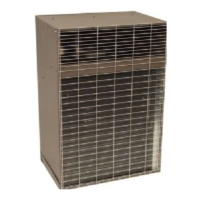
Do you have a question about the National Comfort Products NCPC-418-1010 and is the answer not in the manual?
| Brand | National Comfort Products |
|---|---|
| Model | NCPC-418-1010 |
| Category | Air Conditioner |
| Language | English |
Verify local codes, electrical data, service load, and unit leveling before installation.
Unit must be in an outside wall; TXV coils and hard start kits may be needed.
Masonry walls need lintels; unit extends 3/4" out; use mounting angles.
Flash/seal openings, ensure drainage, and prevent base pan blockage.
Maintain air inlet/outlet clearance, consider decorative grilles, and prevent recirculation.
Ensure fresh air, avoid exhaust fumes, and maintain service access clearance.
Route lines directly, insulate vapor lines, and use heat sinks during brazing.
Check for leaks using dry nitrogen and soap solution or R410a refrigerant.
Install units per manufacturer, route lines, and prepare tubing.
Detailed steps for cutting, fluxing, brazing, and cooling refrigerant line joints.
Procedure for opening and securing the service valve.
Connect pump, evacuate system to 300 microns, and check for leaks.
Continue running pump, check holding vacuum, isolate pump, open valves.
Adjust charge for line length; ensure access panel is in place during operation.
Connect cylinder, introduce refrigerant, and remove gauge set.
Charge to sub-cooling 12-16° and superheat 8-12° at service valve.
Match unit specs, use separate circuit, and install disconnect means.
Connect power to L1/L2 and low voltage to thermostat cable.
Locate thermostat in natural air path, avoiding drafts and obstructions.
Heater energized; safety switches closed during normal operation.
Thermostat call activates fan speed control and compressor contactor.
System stops upon thermostat satisfaction or opening of safety switches.
Diagram illustrating wiring of the condensing unit components.
Charts providing voltage ranges and capacitor values for NCPC models.
Detailed wiring diagram for Madison Series units with component labels.
Chart listing capacitor values for various Madison Series models.
Physical dimensions and refrigerant valve sizes for 1000 Series units.
Electrical data, RLA/LRA, fan motor specs for 1000 Series.
Coil face area/FPI and dimensional drawings for 1000 Series.
Physical dimensions and refrigerant valve sizes for 3000 Series units.
Electrical data, RLA/LRA, fan motor specs for 3000 Series.
Coil face area/FPI and dimensional drawings for 3000 Series.
Physical dimensions and refrigerant valve sizes for 4000 Series units.
Electrical data, RLA/LRA, fan motor specs for 4000 Series.
Coil face area/FPI and dimensional drawings for 4000 Series.
Itemized list of replacement parts for NCPC Series 1000 units.
Itemized list of replacement parts for Madison Series 1000 units.
Itemized list of replacement parts for NCPC Series 3000 units.
Itemized list of replacement parts for Madison Series 3000 units.
Itemized list of replacement parts for NCPC Series 4000 units.
Itemized list of replacement parts for Madison Series 4000 units.
One-year product warranty; extended five-year compressor warranty.
Excludes labor, transportation, and damage from improper installation.
Freight damage not covered; warning against brick facades impeding airflow.
Steps for returning failed compressors to a Bristol wholesaler or NCP.
Process for other parts, requiring PO, RGA number, and factory notification.
General, safety, application, coil, cabinet, and charging specs for the unit.
Specifications for service valves, compressor, and blower motor.
